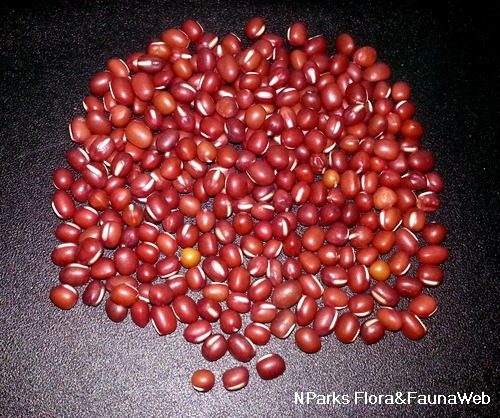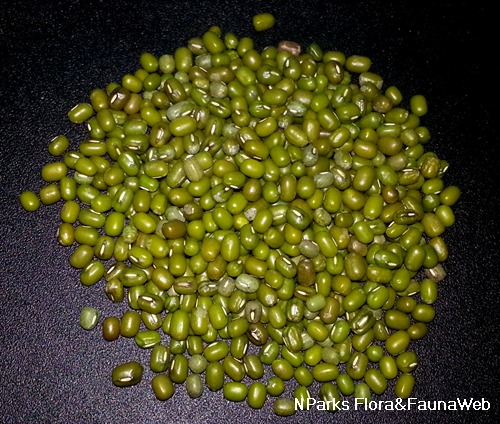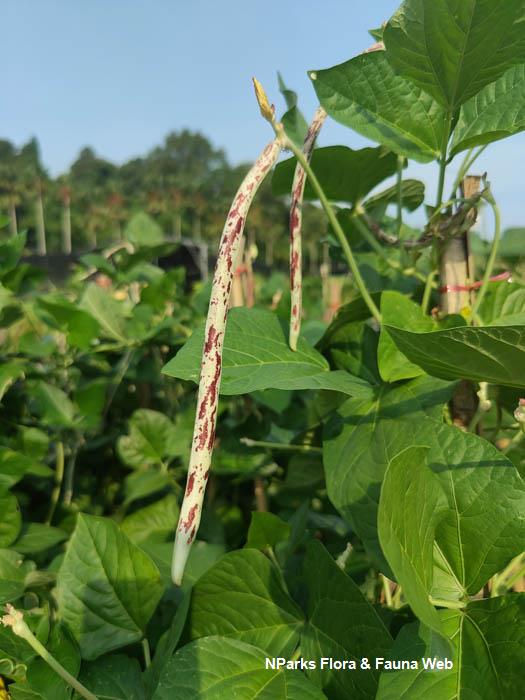
Back
Vigna unguiculata (Sesquipedalis Group) 'Red Noodle'
| Family Name: | Fabaceae (Leguminosae) |
| Synonyms: | Vigna unguiculata subsp. sesquipedalis 'Chinese Red Noodle' |
| Common Name: | Red Noodle Bean |
Name
Classifications and Characteristics
| Plant Division | Angiosperms (Flowering Seed Plants) (Dicotyledon) |
|---|---|
| Plant Growth Form | Climber |
| Lifespan (in Singapore) | Annual |
| Mode of Nutrition | Autotrophic |
| Maximum Height | 2 m to 4 m |
Description and Ethnobotany
| Growth Form | Climbing vine up to 2 m tall. |
|---|---|
| Foliage | Compound leaves are composed of 3 ovate leaflets. |
| Flowers | Light purple flowers are composed of 4 prominent, round petals with a small keel hidden below the petals. The upper petals are decorated by a thin row of dark purple markings and 2 small yellow spots. |
| Fruit | The fruit is a long, narrow, dark red pod up to 45 cm long. They occur in small clusters of 1-3. |
| Ethnobotanical Uses | Edible Plant Parts : Edible Fruits, Edible Seeds Food (Fruit or Vegetable): The pods can be consumed as a cooked vegetable. They are excellent grilled or stir-fried. Some consider the flavour to be richer and the texture firmer than other cultivars. |
Landscaping Features
| Landscape Uses | Trellis / Arbour / Pergola |
|---|---|
| Thematic Landscaping | Economic Garden |
Plant Care and Propagation
| Light Preference | Full Sun |
|---|---|
| Water Preference | Moderate Water |
| Rootzone Tolerance | Well-Drained Soils, Fertile Loamy Soils |
| Propagation Method | Seed |
Foliar
| Mature Foliage Colour(s) | Green |
|---|---|
| Foliar Type | Compound |
| Foliar Attachment to Stem | Petiolate |
| Foliar Shape(s) | Non-Palm Foliage (Ovate) |
| Foliar Venation | Pinnate / Net |
Fruit, Seed and Spore
| Mature Fruit Colour(s) | Red |
|---|---|
| Mature Fruit Texture(s) | Wrinkled |
| Fruit Classification | Simple Fruit |
| Fruit Type |
Image Repository
Others
| Master ID | 32112 |
|---|---|
| Species ID | 6518 |
| Flora Disclaimer | The information in this website has been compiled from reliable sources, such as reference works on medicinal plants. It is not a substitute for medical advice or treatment and NParks does not purport to provide any medical advice. Readers should always consult his/her physician before using or consuming a plant for medicinal purposes. |





